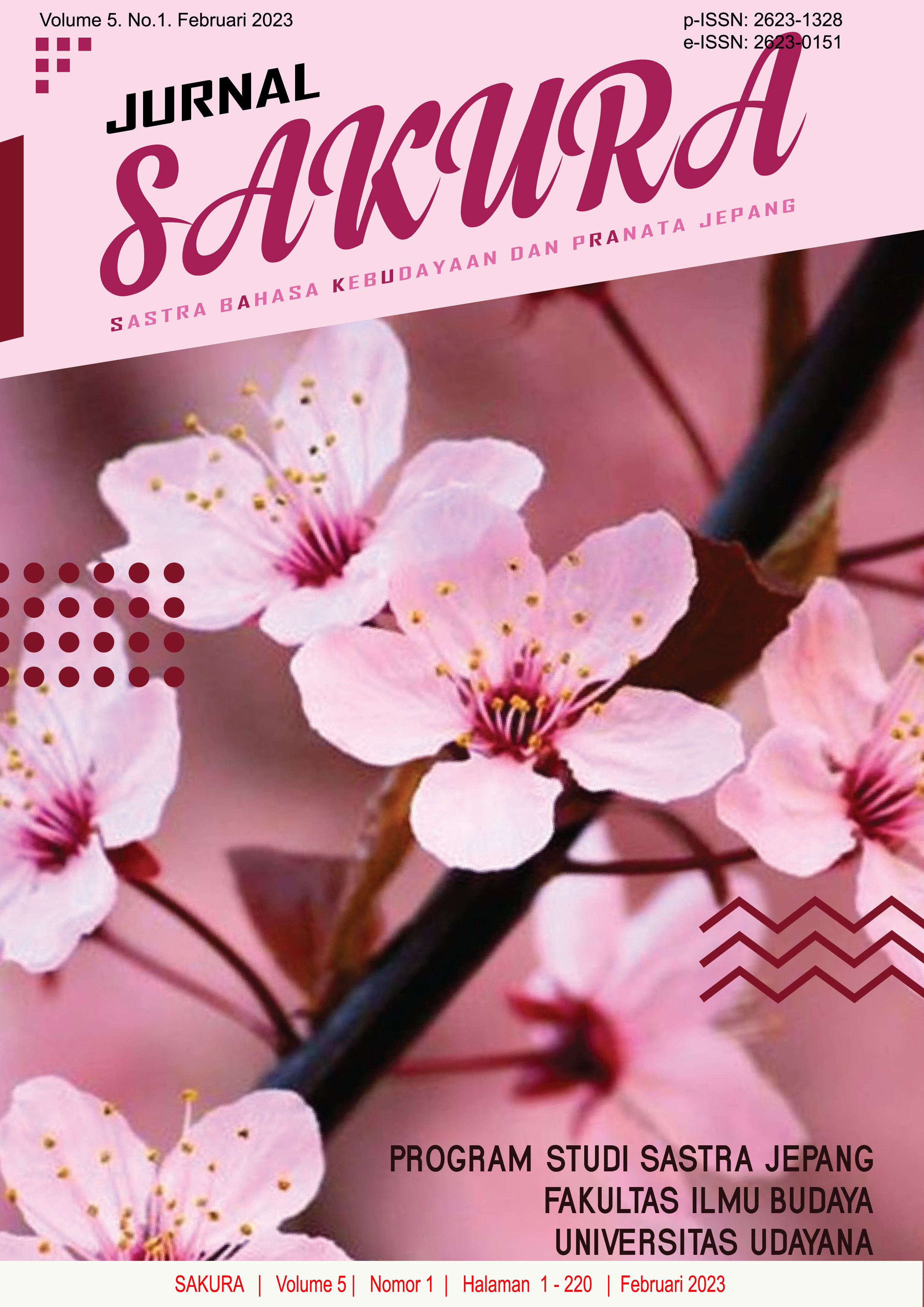Makna Simbol Topeng Tengu dalam Anime Kimetsu no Yaiba karya Koyoharu Gotouge: Kajian Semiotika
Abstract
The purpose of this research is to describe the meaning of the tengu mask symbol in the anime Kimetsu no Yaiba by Koyoharu Gotouge. The reason for this research is that at every opportunity to practice with his teacher, Tanjiro saw Urokodaki teacher always wearing a red tengu mask which was considered to have a certain meaning or symbol for Japanese society. This study uses a qualitative method. Data collection techniques in this study were obtained by observing and noting study techniques. Then, the data analysis technique uses descriptive techniques. Furthermore, the theory used is related to the relationship of signification by using Pierce's triadic triangle theory which consists of 3 elements, namely, representamen, interpretant and object. Next, the theory of trichotomous signs in the symbol section, the tengu mask and the theory of red color. The data source for this research is the anime Kimetsu no Yaiba. The results of the discussion are, the meaning of the symbol of the tengu mask in the anime Kimetsu no Yaiba by Koyoharu Gotouge, namely as a figure of a teacher or martial arts trainer who has a strong, firm, disciplined, humorous, humanist, wise, optimistic, and motivating character.
Downloads
References
Berger, Arthur Asa. (2010). Pengantar Semiotika: Tanda-Tanda dalam Kebudayaan Kontemporer. Terjemahan M. Dwi Marianto dari Signs in Contemporary Cul-ture: An Introduction to Semiotics (1984). Yogyakata: Tiara Wacana.
Danesi, Marcel. (2011). Messages, Signs, and Meanings. Toronto: Canadian
Scholars' Press Inc.
Emzir, Rohman. (2017). Teori dan Pengkajian Sastra. Jakarta: Rajawali Pers.
Gotouge, Koyoharu. (2019). Kimetsu no Yaiba. Shueisha.
Hoed, Benny Hoedoro. (2011). Semiotik & Dinamika Sosial Budaya. Depok: Komunitas Bambu.
Kotobank.Jp. 『天狗』Melalui,
Mahsun. (2012). Metode Penelitian Bahasa: Tahapan Strategi, Metode, dan Tekniknya. Jakarta: Rajawali Pers.
Moleong, Lexy J. 2016. Metode Penelitian Kualitatif. Bandung: Remaja Rosdakarya.
Nakayama, Kira. (2017). Kisah Tengu dalam Masyarakat Jepang. Melalui,
Okada, Yasunobu dan Takuji Natori. (2013). 『ペルソナ、伝統的仮面の象徴的意味と箱庭における顔的表現』CiNii Articles. Kyōtobunkyōdaigaku.
Pateda, Mansoer. (2001). Semantik Leksikal. Jakarta: Rineka Cipta.
Pradopo, Rachmat Djoko. (1995). Beberapa Teori Sastra, Metode Kritik, dan Penera-pannya. Yogyakarta: Pustaka Pelajar.
Saraswati. (2018). 6 Topeng Tradisional Jepang dan Maknanya dari Unyu sampai Ngeri. Melalui,
Semi, Atar. (1993). Metode Penelitian Sastra. Bandung: Angkasa.
Sobur, Alex. (2003). Semiotika Komunikasi. Bandung: Remaja Rosdakarya.
Sudaryanto. (1993). Metode dan Aneka Teknik Analisis Bahasa: Pengantar penelitian wahana kebudayaan secara linguistis. Universitas Michigan: Duta Wacana Uni-versity Press.
Sulatri, Ni Luh Putu Ari dan Silvia Damayanti. (2022). “Ideologi di Balik Mitos da-lam Cerpen Akagaeru Karya Shimaki Kensaku: Kajian Semiologi Roland Barthes”. Jurnal SAKURA, 4(1), hlm. 92-107.
Tinarbuko, Sumbo. (2008). Semiotika Komunikasi Visual. Yogyakarta: Jalasutra.
Tresnasari, Ningrum. (2019). “Representasi dan Interpretasi Kaomoji (Emotikon Ba-hasa Jepang) Melalui Pendekatan Semiotika Pierce”. Jurnal SAKURA, 1(1), hlm. 13-18.
Wuryanto, Agus. (1998). Topeng Lenggeran di Kabupaten Wonosobo. Skripsi S1.Yogyakarta.
Yamane, Toi. (2020). “Kepopuleran dan Penerimaan Anime Jepang di Indonesia”. Jurnal AYUMI, 7(1), hlm. 68-82.
Yudha. (2018). Pencinta Budaya Jepang? Pastikan Kamu Tahu 10 Arti Warna di Je-pang ini. Melalui,













